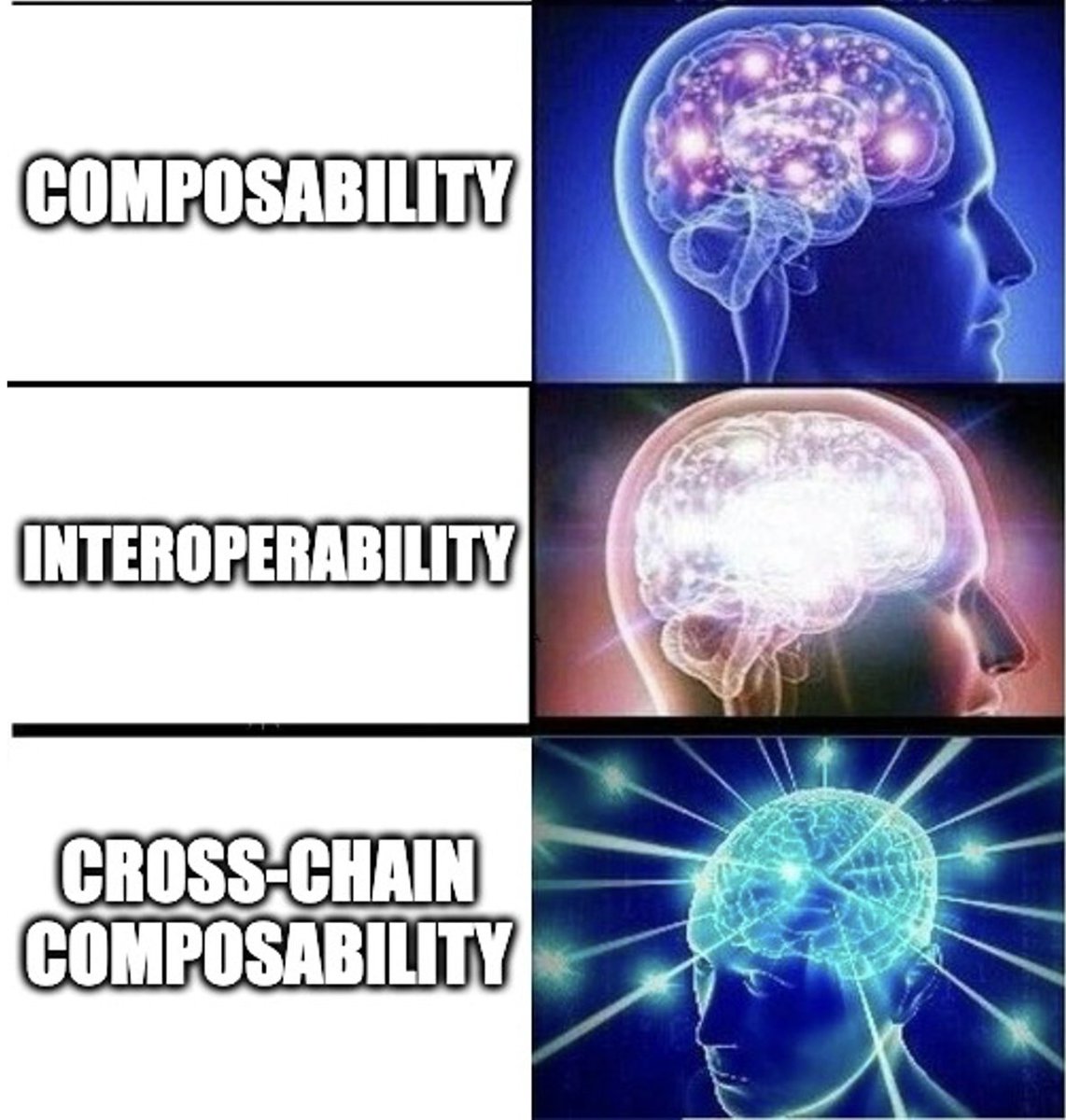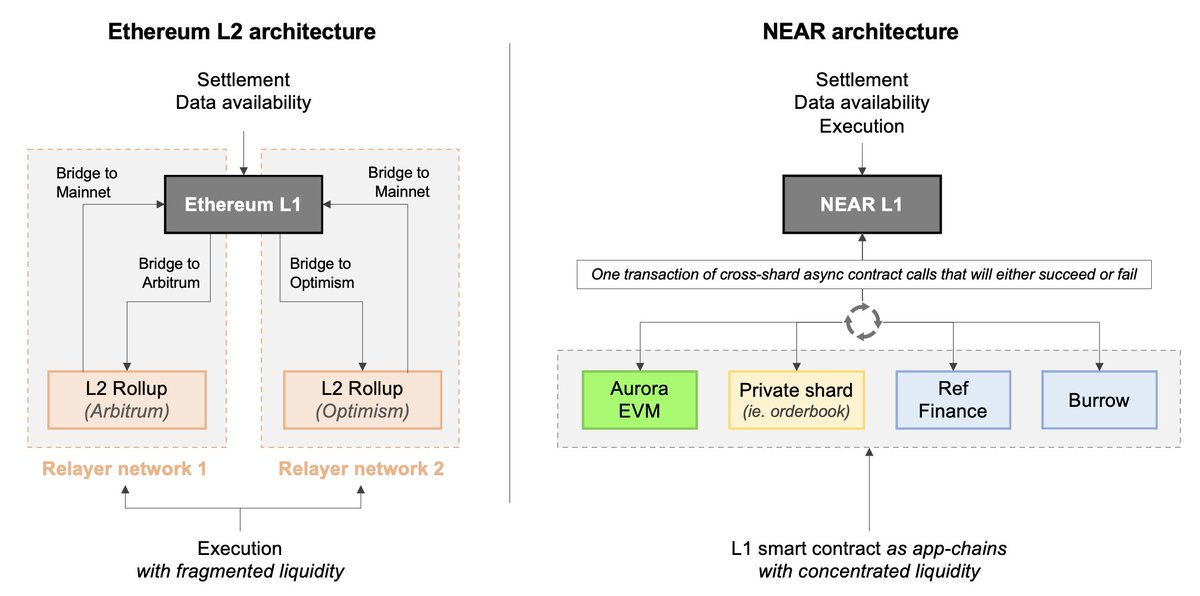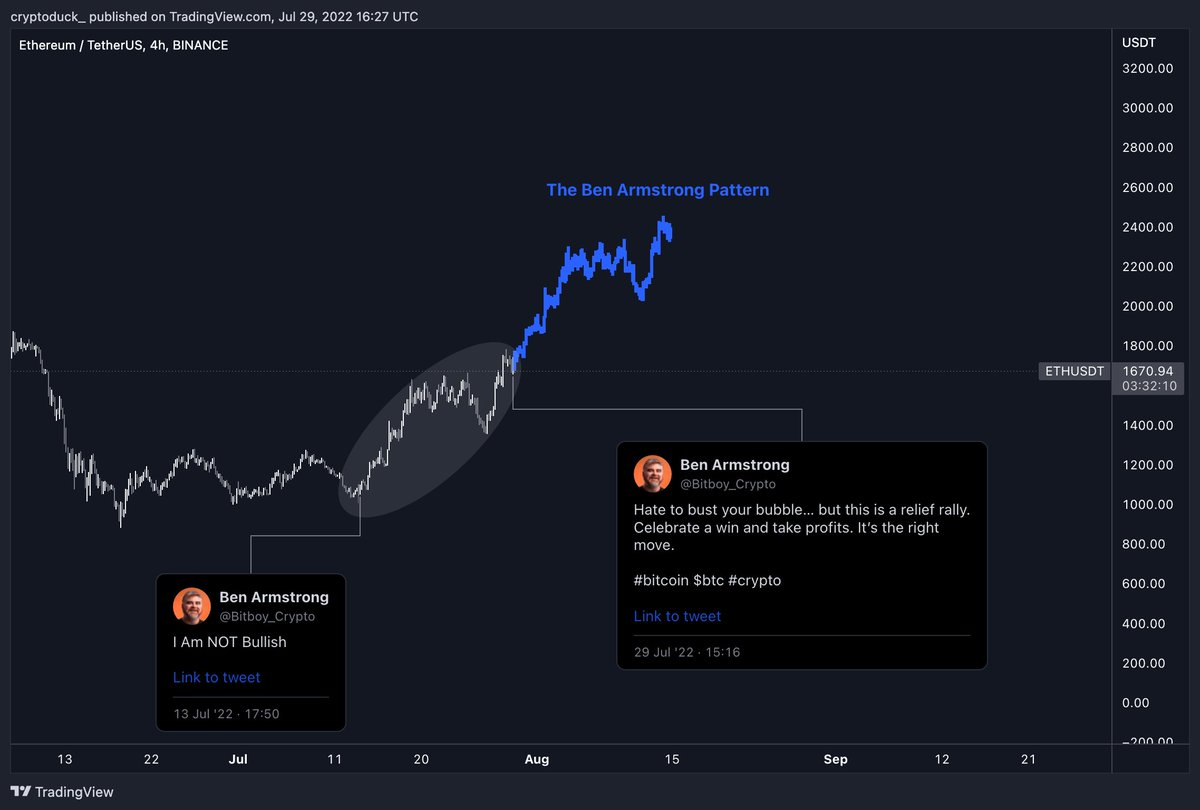
2/ This thread aims to provide the main takeaways from the more extensive research by @proximityfi that I personally wrote and you can find here
I've tried to make it as simple to understand as possible
medium.com/@ProximityFi/e…
I've tried to make it as simple to understand as possible
medium.com/@ProximityFi/e…
3/ The article delves into
1. Composability & its importance
2. Interoperability
3. Cross-chain bridges vs Sharding vs NEAR's Nightshade
4. How NEAR achieves true scalability & enables cross-chain composability
5. Real-world applications
Let's start with basic definitions
1. Composability & its importance
2. Interoperability
3. Cross-chain bridges vs Sharding vs NEAR's Nightshade
4. How NEAR achieves true scalability & enables cross-chain composability
5. Real-world applications
Let's start with basic definitions
4/ COMPOSABILITY
Composability is the ability to combine distinct components to create new systems
It allows dApps/DAOs within the same chain to seamlessly communicate & work with each other as devs can freely use, modify & integrate open-source code in their apps
Composability is the ability to combine distinct components to create new systems
It allows dApps/DAOs within the same chain to seamlessly communicate & work with each other as devs can freely use, modify & integrate open-source code in their apps
https://twitter.com/cdixon/status/1495639908517560322
5/ Examples of composability:
- Token swaps
- Flash loans
- Governance
- Identity management
- LP position from a DEX as collateral in a Money Market
- Borrowing against your NFT or lending it out
- The ability to combine DeFi features w/ GameFi, DAOs & more Web 3.0 primitives
- Token swaps
- Flash loans
- Governance
- Identity management
- LP position from a DEX as collateral in a Money Market
- Borrowing against your NFT or lending it out
- The ability to combine DeFi features w/ GameFi, DAOs & more Web 3.0 primitives

6/ COMPOSABILITY VS INTEROPERABILITY
While composability allows for smart contracts to interact w/ others within the same chain; interoperability is the ability for chains to communicate among each other, even though they differ in consensus, data availability or block formation
While composability allows for smart contracts to interact w/ others within the same chain; interoperability is the ability for chains to communicate among each other, even though they differ in consensus, data availability or block formation

7/ CROSS-CHAIN COMPOSABILITY
It can be defined by combining the definitions of composability & interoperability:
Cross-chain composability is the ability for dApps & DAOs on different chains/shards to communicate and interact with each other in a permissionless and seamless way
It can be defined by combining the definitions of composability & interoperability:
Cross-chain composability is the ability for dApps & DAOs on different chains/shards to communicate and interact with each other in a permissionless and seamless way

8/ While composability is one of the biggest innovations of Web 3.0, interoperability is still a complex problem that many are trying to solve
Two main solutions have been proposed so far
1) Cross-chain bridges
2) Sharded blockchains
This thread focuses on sharded blockchains
Two main solutions have been proposed so far
1) Cross-chain bridges
2) Sharded blockchains
This thread focuses on sharded blockchains
9/ Cross-chain bridges effectively connect chains with different target use cases and properties that might not otherwise be compatible
But these bridges face the bridging trilemma and don't allow for cross-chain composability
But these bridges face the bridging trilemma and don't allow for cross-chain composability

10/ Solutions such as Stargate solve the trilemma and bring composability to the table as it can transfer native assets across chains
Yet it introduces other risks and major complexities such as exhaustion of LPs, rebalancing issues or widespread reversion
*more info on article
Yet it introduces other risks and major complexities such as exhaustion of LPs, rebalancing issues or widespread reversion
*more info on article
11/ Sharded blockchains arose to solve scalability & tackle the blockchain trilemma, a concept coined by @VitalikButerin
Sharding splits the blockchain into multiple chains (shards) and creates an ecosystem of heterogeneous blockchains that have a working interoperable subsystem
Sharding splits the blockchain into multiple chains (shards) and creates an ecosystem of heterogeneous blockchains that have a working interoperable subsystem

12/ Although sharded blockchains may solve scalability and offer an interoperable ecosystem, composability across chains is limited as
- Users constantly need to bridge capital
- There is fragmentation of liquidity, users, resources, etc.
- Message passing solutions are unproven
- Users constantly need to bridge capital
- There is fragmentation of liquidity, users, resources, etc.
- Message passing solutions are unproven
13/ $NEAR: NIGHTSHADE
Nightshade is NEAR’s solution to scalability & cross-chain composability
Contrary to Cosmos or Polkadot, NEAR is a sharded blockchain modeled as a single L1: shards aren't different chains but smart contracts that can run optimized execution environments!

Nightshade is NEAR’s solution to scalability & cross-chain composability
Contrary to Cosmos or Polkadot, NEAR is a sharded blockchain modeled as a single L1: shards aren't different chains but smart contracts that can run optimized execution environments!


14/ As Nightshade doesn't use a Beacon chain but chunks, it allows NEAR to scale infinitely with the number of shards and dynamically (due to dynamic resharding)
To read more about sharding, Nightshade, chunks, etc you can read the full article or visit
near.org/papers/nightsh…
To read more about sharding, Nightshade, chunks, etc you can read the full article or visit
near.org/papers/nightsh…
15/ ENABLING CROSS-SHARD COMPOSABILITY
$Aurora & other shards aren't rollups but execution environments supported as smart contracts
Aurora tx's are actually wrapped into NEAR tx's that are sent to the Aurora contract
All settlement, data availability & execution are on NEAR
$Aurora & other shards aren't rollups but execution environments supported as smart contracts
Aurora tx's are actually wrapped into NEAR tx's that are sent to the Aurora contract
All settlement, data availability & execution are on NEAR

16/ As $NEAR is modeled as a single L1, smart contracts can be composed even if they are executing on different shards and running their code in different environments
For example, NEAR Native and EVM contracts are composable on NEAR’s mainnet today!
For example, NEAR Native and EVM contracts are composable on NEAR’s mainnet today!

17/ It takes several transactions to swap across different L2s on Ethereum
But because NEAR is asynchronous & non-blocking, the user only sees 1 transaction when cross-shard contract calls are made from one environment to another
But because NEAR is asynchronous & non-blocking, the user only sees 1 transaction when cross-shard contract calls are made from one environment to another
18/ This means that without bridging or any complicated UX, devs/users can use any execution environment that suits their needs:
you can run a smart contract for the EVM, a rollup, a new privacy environment or even a single app within a private shard for enhanced performance
you can run a smart contract for the EVM, a rollup, a new privacy environment or even a single app within a private shard for enhanced performance
19/ dApps get the benefits of running their own chain:
- Customization & flexibility
- L1 performance: instant finality, higher TPS
- Improved UX/UI: no bridging, direct access to concentrated liquidity
- Higher security
without extra work such as consensus, storage, validators
- Customization & flexibility
- L1 performance: instant finality, higher TPS
- Improved UX/UI: no bridging, direct access to concentrated liquidity
- Higher security
without extra work such as consensus, storage, validators
20/ REAL WORLD APPLICATIONS
1) Forget about bridging
Even though users might be interacting with other shards, they won't notice since they will be on NEAR mainnet using their NEAR wallet
Capital doesn't need to be bridged when using a different shard or execution environment
1) Forget about bridging
Even though users might be interacting with other shards, they won't notice since they will be on NEAR mainnet using their NEAR wallet
Capital doesn't need to be bridged when using a different shard or execution environment
21/ For example, you might be trading on @finance_ref but, if the quote is better on @trisolarislabs, the trade will take place on the Aurora environment and the user won't even notice
You can even trade tokens on NEAR Mainnet that are only available on Aurora!
You can even trade tokens on NEAR Mainnet that are only available on Aurora!
https://twitter.com/finance_ref/status/1516464460130619412
22/ The Rainbow Bridge isn't needed for cross-shard contract calls: the UI just signs the required tx
This differs from cross-chain bridges built on omnichain protocols & from other sharded blockchains which do need to bridge from one interoperable chain to another
This differs from cross-chain bridges built on omnichain protocols & from other sharded blockchains which do need to bridge from one interoperable chain to another
23/
2) Say goodbye to fragmented liquidity
Unlike other scalability solutions, liquidity is NOT fragmented on NEAR
Users / devs can directly access liquidity across the whole NEAR ecosystem in a single tx thanks to the shared L1 for data & asynchronous base layer execution
2) Say goodbye to fragmented liquidity
Unlike other scalability solutions, liquidity is NOT fragmented on NEAR
Users / devs can directly access liquidity across the whole NEAR ecosystem in a single tx thanks to the shared L1 for data & asynchronous base layer execution
24/ On ETH, you must bridge to Arbitrum to use a deeper LP
On NEAR, you can access all liquidity without leaving NEAR Mainnet, as DEX aggregators can trade across the whole ecosystem (ie. AMMs on Mainnet + AMMs on Aurora + Orderbooks on private shards + AMMs on a rollup)
On NEAR, you can access all liquidity without leaving NEAR Mainnet, as DEX aggregators can trade across the whole ecosystem (ie. AMMs on Mainnet + AMMs on Aurora + Orderbooks on private shards + AMMs on a rollup)
25/
3) Welcome concentration of dApps with true scalability
When an app becomes popular and congested, it may opt to develop its own chain
Or they might just want to make it more customizable and avoid the limitations of a simple EVM smart contract
3) Welcome concentration of dApps with true scalability
When an app becomes popular and congested, it may opt to develop its own chain
Or they might just want to make it more customizable and avoid the limitations of a simple EVM smart contract
26/ Such cases, among others, are dYdX or DeFi Kingdoms
So not only are we having a more fragmented ecosystem of blockchains but we are also now getting dApps that develop their own chain to get the performance & customization they need
That might eventually become a problem:
So not only are we having a more fragmented ecosystem of blockchains but we are also now getting dApps that develop their own chain to get the performance & customization they need
That might eventually become a problem:
27/ Before, a user had to bridge their funds to use a new chain
Now, you also have to bridge your funds if you wanna use a specific dApp!
This is even true in the ETH2.0 + L2 scaling model where both liquidity & apps will be fragmented across a number of L2s
Now, you also have to bridge your funds if you wanna use a specific dApp!
This is even true in the ETH2.0 + L2 scaling model where both liquidity & apps will be fragmented across a number of L2s
28/ This doesn't occur in NEAR
Orderbooks could move to a shard but traders wouldn't even notice the change!
This removes a huge barrier for mass adoption & offers a great opportunity for projects who aim for performance and customization without sacrificing user experience
Orderbooks could move to a shard but traders wouldn't even notice the change!
This removes a huge barrier for mass adoption & offers a great opportunity for projects who aim for performance and customization without sacrificing user experience
29/ TL;DR (1)
- $NEAR is a sharded blockchain modeled as a single L1
- Shards aren't chains but execution environments supported as smart contracts
- Such execution, running on a shared L1 for data and async base layer execution, allows for true cross-shard composability
- $NEAR is a sharded blockchain modeled as a single L1
- Shards aren't chains but execution environments supported as smart contracts
- Such execution, running on a shared L1 for data and async base layer execution, allows for true cross-shard composability
30/ TL;DR (2)
Such cross-shard composability offers:
- No need for bridging
- Concentrated liquidity across the ecosystem
- Instant guaranteed finality with single transactions
- Optimized quotes for traders
- Higher security in a more efficient market
- Improved UI/UX
Such cross-shard composability offers:
- No need for bridging
- Concentrated liquidity across the ecosystem
- Instant guaranteed finality with single transactions
- Optimized quotes for traders
- Higher security in a more efficient market
- Improved UI/UX
31/ If you enjoyed this thread consider following @resdegen and @proximityfi and RT the main tweet!
There are more articles to come, if you wanna keep up with them stay tuned!
There are more articles to come, if you wanna keep up with them stay tuned!
https://twitter.com/resdegen/status/1565040519255711744
DISCLOSURES: PROXIMITY HOLDS $NEAR, $AURORA & TOKENS THAT MAY BE ASSOCIATED WITH OTHER AFOREMENTIONED APPS. THESE STATEMENTS ARE INTENDED TO DISCLOSE ANY CONFLICT OF INTEREST AND SHOULDN'T BE MISCONSTRUED AS A RECOMMENDATION TO PURCHASE OR SELL ANY TOKEN, OR TO USE ANY PROTOCOL
THE CONTENT IS FOR INFORMATIONAL PURPOSES ONLY AND YOU SHOULD NOT MAKE INVESTMENT DECISIONS BASED SOLELY ON IT. THIS IS NOT INVESTMENT ADVICE. BLOCKCHAIN TECHNOLOGY IS EXPERIMENTAL AND INHERENTLY RISKY
• • •
Missing some Tweet in this thread? You can try to
force a refresh
















